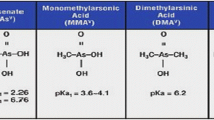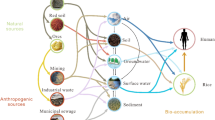Abstract
The arsenic contamination accident in Yangzonghai Lake, Yunnan has been of wide concern. In order to investigate the arsenic distribution and concentration trends after the accident, samples including lake water, sediments, soil, aquatic organisms and crops were collected in November 2008, as well as in February, May and September 2009. The average arsenic concentrations (arithmetic average) in lake water in the four sampling events were 176.9, 147.3, 159.3, and 161.1 μg/L, while those in the sediments were 32.87, 62.41, 62.99, and 46.96 μg/g, respectively. The highest content of total arsenic in soil in the vicinity of Yangzonghai was 23.33 μg/g, which was below the limits of the relevant national standard. The total arsenic levels in most aquatic plants were in the range of 100–200 μg/g, with Vallisneria natans (Lour.) Hara having the highest concentration of ∼300 μg/g. The arsenic levels of fish and shrimps were in the range of 1.52–11.4 μg/g (dry weight).
Similar content being viewed by others
References
Mandal BK, Suzuki KT. Arsenic round the world: A review. Talanta, 2002, 58(1): 201–235
Liu Y. Joking remarks of Yangzonghai: Review of contamination accident. Water & Wastewater Information, 2009, (2): 39–41
Environmental Protection Agency of Yunnan. Highland Lake Water Quality Report. 2008–2010. http://www.ynepb.gov.cn/color/default.aspx
U.S. Environmental Protection Agency. Determination of trace elements in waters and wastes by inductively coupled plasma-mass spectrometry (EPA 200.8). 1994
Wen XY, Song JW, Tan YL, Zhang FL, Deng JF. The research on the measurement for As, Sb, Se in drinking water directly with ICP-MS. Environmental Monitoring in China, 2005, 21(3): 22–25
China Ministry of Agricutrue. NY/T 1377-2007. Determination of pH in Soils. Beijing: 2007
Maest AS, Pasilis SP, Miller LG, Nordstrom DK. Redox geochemistry of arsenic and iron in Mono Lake, California, USA. A a Balkema: Rotterdam, 1992, 507–511
Faust SD, Winka A, Belton T, Tucker R. Assessment of the chemical and biological significance of arsenical compounds in a heavlily contaminated watershed. 2. Analysis and distribution of several arsenical species. J Environ Sci Health Part A-Environ Sci Eng Toxic Hazard Subst Control, 1983, 18(3): 389–411
Faust SD, Winka AJ, Belton T. An assessment of chemical and biological significance of arsenical species in the Maurice River Drainage-Basin (NJ) 2. partitioning of arsenic into bottom sediments. J Environ Sci Health Part A-Environ Sci Eng Toxic Hazard Subst Control, 1987, 22(3): 239–262
Serfor-Armah Y, Nyarko BJB, Adotey DK, Dampare SB, Adomako D. Levels of arsenic and antimony in water and sediment from Prestea, a gold mining town in Ghana and its environs. Water Air Soil Pollut, 2006, 175(1–4): 181–192
Bright DA, Dodd M, Reimer KJ. Arsenic in subArctic lakes influenced by gold mine effluent: The occurrence of organoarsenicals and ‘hidden’ arsenic. Sci Total Environ, 1996, 180(2): 165–182
Arain MB, Kazi TG, Baig JA, Jamali MK, Afridi HI, Shah AQ, Jalbani N, Sarfraz RA. Determination of arsenic levels in lake water, sediment, and foodstuff from selected area of Sindh, Pakistan: Estimation of daily dietary intake. Food and Chemical Toxicology, 2009, 47(1): 242–248
Azcue JM, Nriagu JO. Impact of abandoned mine tailings on the arsenic concentrations in Moira lake, Ontario. J Geochem Explor, 1995, 52(1–2): 81–89
China Ministry of Health, Standardization Administration of the People’s Republic of China. Standards for Drinking Water Quality (GB 5749-2006). Beijing, 2006
World Health Organization. Guidelines for Drinking-Water Quality, third edition. World Health Organization, Geneva 2004, 306
Paikaray S, Banerjee S, Mukherji S. Sorption of arsenic onto Vindhyan shales: Role of pyrite and organic carbon. Curr Sci, 2005, 88(10): 1580–1585
Reza A, Jean JS, Yang HJ, Lee MK, Woodall B, Liu CC, Lee JF, Luo SD. Occurrence of arsenic in core sediments and groundwater in the Chapai-Nawabganj District, northwestern Bangladesh. Water Res, 2010, 44(6): 2021–2037
Shaw D. Mobility of arsenic in saturated, laboratory test sediments under varying pH conditions. Eng Geol, 2006, 85(1–2): 158–164
McArthur JM, Ravenscroft P, Safiulla S, Thirlwall MF. Arsenic in groundwater: Testing pollution mechanisms for sedimentary aquifers in Bangladesh. Water Resour Res, 2001, 37(1): 109–117
Mukherjee AB, Bhattacharya P. Arsenic in groundwater in the Bengal Delta Plain: Slow poisoning in Bangladesh. Environ Rev, 2001, 9(3): 189–220
Bhattacharya P, Jacks G, Ahmed KM, Routh J, Khan AA. Arsenic in groundwater of the Bengal Delta Plain aquifers in Bangladesh. Bull Environ Contam Toxicol, 2002, 69(4): 538–545
Mazej Z, Germ M. Trace element accumulation and distribution in four aquatic macrophytes. Chemosphere, 2009, 74(5): 642–647
Lee CK, Low KS, Hew NS. Accumulation of arsenic by aquatic plants. Sci Total Environ, 1991, 103(2–3): 215–227
Nicholson LW, Rengan K. Determination of arsenic in some lake-michigan fish using neutron-activation analysis. J Radioanal Chem, 1979, 54(1–2): 355–360
Shah AQ, Kazi TG, Baig JA, Arain MB, Afridi HI, Kandhro GA, Wadhwa SK, Kolachi NF. Determination of inorganic arsenic species (As3+ and As5+) in muscle tissues of fish species by electrothermal atomic absorption spectrometry (ETAAS). Food Chem, 2010, 119(2): 840–844
Shah AQ, Kazi TG, Arain MB, Jamali MK, Afridi HL, Jalbani N, Baig JA, Kandhro GA. Accumulation of arsenic in different fresh water fish species—potential contribution to high arsenic intakes. Food Chem, 2009, 112(2): 520–524
Has-Schon E, Bogut I, Strelec I. Heavy metal profile in five fish species included in human diet, domiciled in the end flow of River Neretva (Croatia). Arch Environ Contam Toxicol, 2006, 50(4): 545–551
Delgado-Andrade C, Navarro M, Lopez H, Lopez MC. Determination of total arsenic levels by hydride generation atomic absorption spectrometry in foods from south-east Spain: Estimation of daily dietary intake. Food Addit Contam, 2003, 20(10): 923–932
de Rosemond S, Xie QL, Liber K. Arsenic concentration and speciation in five freshwater fish species from Back Bay near Yellowknife, NT, Canada. Environ Monit Assess, 2008, 147(1–3): 199–210
Jankong P, Chalhoub C, Kienzl N, Goessler W, Francesconi KA, Visoottiviseth P. Arsenic accumulation and speciation in freshwater fish living in arsenic-contaminated waters. Environ Chem, 2007, 4(1): 11–17
Al Rmalli SW, Haris PI, Harrington CF, Ayub M. A survey of arsenic in foodstuffs on sale in the United Kingdom and imported from Bangladesh. Sci Total Environ, 2005, 337(1–3): 23–30
Moretto AL, Cadore S. Determination of arsenic in food samples by hydride generation-atomic absorption spectrometry. Microchim. Acta, 2004, 146(3–4): 239–244
National programme on safety food. NY5115-2008 Safety milled rice criteria of PR China. Beijin: China Ministry of Health. 2008
National programme on safety food. NY5302-2005 Safety crop criteria of PR China. Beijin: China Ministry of Health. 2005
National programme on safety food. NY5008-2008 Safety Brassica criteria of PR China. Beijing: China Ministry of Health. 2008
National programme on safety food. NY5003-2008 Safety cabbage criteria of PR China. China Ministry of Health. 2008
Jung MC, Thornton I, Chon HT. Arsenic, Sb and Bi contamination of soils, plants, waters and sediments in the vicinity of the Dalsung Cu-W mine in Korea. Sci Total Environ, 2002, 295(1–3): 81–89
Author information
Authors and Affiliations
Corresponding author
Rights and permissions
About this article
Cite this article
Wang, Z., He, B., Pan, X. et al. Levels, trends and risk assessment of arsenic pollution in Yangzonghai Lake, Yunnan Province, China. Sci. China Chem. 53, 1809–1817 (2010). https://doi.org/10.1007/s11426-010-4039-3
Received:
Accepted:
Published:
Issue Date:
DOI: https://doi.org/10.1007/s11426-010-4039-3




